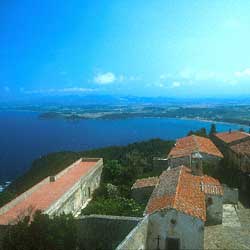|
 The
stretch of coastline from Livorno to Piombino is known as the Coast
of the Etruscans because they settled there and exploited the area's
enormous agricultural and mineral resources. The powerful Etruscan fleet
criss-crossed the Tyrrhenian Sea from the ports of Vada and Baratti,
and Populonia was powerful enough to issue its own coinage. Historic
and tourist centres include Castiglioncello, Rosignano Marittimo,
Cecina, Bibbona, Campiglia Marittima, Vada,
San Vincenzo, and Castagneto Carducci. The latter owes part
of its name to the poet Giosuè Carducci who lived there when he
was very young, and who remained attached to it throughout his life. The
stretch of coastline from Livorno to Piombino is known as the Coast
of the Etruscans because they settled there and exploited the area's
enormous agricultural and mineral resources. The powerful Etruscan fleet
criss-crossed the Tyrrhenian Sea from the ports of Vada and Baratti,
and Populonia was powerful enough to issue its own coinage. Historic
and tourist centres include Castiglioncello, Rosignano Marittimo,
Cecina, Bibbona, Campiglia Marittima, Vada,
San Vincenzo, and Castagneto Carducci. The latter owes part
of its name to the poet Giosuè Carducci who lived there when he
was very young, and who remained attached to it throughout his life.
Castiglioncello
is the most popular summer resort on the Livorno coastline; it's
a pleasant town and the Castello Pasquini hosts many cultural events
and shows. Nearby, slightly inland, there is Rosignano Solvay,
home to the Solvay factory that produces caustic soda, carbonate, and
bicarbonate of soda. There is also a beach resort with a long beach edged
with low rocks.
One of the best-equipped
beaches in
Tuscany is San Vincenzo, which has three miles of beach,
next to which there is also a tower built by the Pisans in
1304.
Driving along an attractive road between olive groves, you come to the
extremely old village of Campiglia Marittima; there was already
a castle belonging to the Della Gherardesca family here in the
year 1000. The town council, in collaboration with the Department of Archaeology
and Art History at the University of Siena, has established the Parco
Minerario dei Monti della Campiglia. It's a kind of open-air archive
that starts from the Etruscan period and runs all the way through
to man's recent drilling in the rocks of the area.
There are a number of Etruscan coastal cities. Populonia
is one of the most important, where the Etruscans exploited the
nearby iron mines; lots of remains are on display in the Museo Etrusco,
and the splendid Colatoi and Flabelli tombs are also
worth seeing. Then there is Castiglioncello, where an entire necropolis
consisting of over two hundred tombs was found near the railway station;
many of the finds are on display in the Museo Archeologico di Castiglioncello.
Finally there is Campiglia Marittima, where the Etruscans built
forges to work the metal extracted from the surrounding hills.
Picture by Sandro Santioli
|